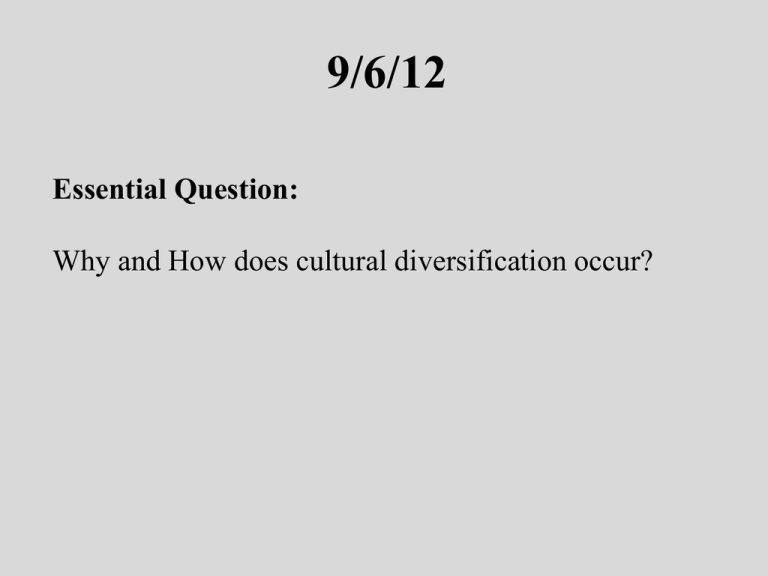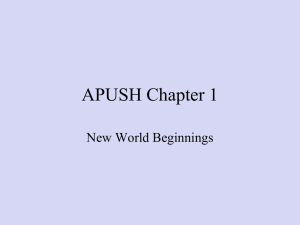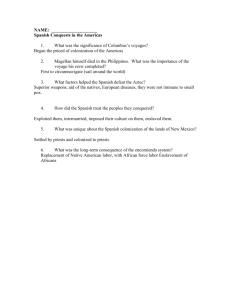A Continent of Villages
advertisement

9/6/12 Essential Question: Why and How does cultural diversification occur? A Continent of Villages Settling the Continent By first contact with Europeans in 15th c., the Native-American population was a diverse mixture of cultures and languages, existing through adaptation to many different regional environments. Migration hypothesis=Indian peoples came from a common stock of Asian migrants, arriving from a Northwestern land passage, and had experienced a long and independent history in the Americas. TIMEFRAME: 25,000 – 30,000 yrs. ago Motivation: Summers were warm, and winters cold, dry and snow free- perfect environment for large mammals. Thus, Hunter gatherer societies followed them and thrived on the limitless land. Kinship systems developed as people in densely populated regions formed clans. (Cliques) Stuck in this school…Who goes with whom? Tribes would emerge as clans binded together based on ethnic, linguistic, and territorial unity. What’s the connection to the main idea? Cultural Regions of North America on the Eve of Colonization Many distinct ecological areas of North America emerge: Northwest, Great Plains, Northeast, West Coast, Great Basin, Southwest, South. The most densely populated areas become the Southwest, The South, and The Northeast. “Funny how things don’t change” RESPONSE: It is estimated that the population of North America was between 20 and 30 million when Europeans arrived…about the same as the continent of Culture area Europe. Explain the significance of this fact. As tribes spread throughout the continent, different ways of life emerge, largely based on geographic factors. 1. Hunting Tradition- Centered on the relationship between Hunters and prey, and celebrated the existence of a “Master of Animals.” 2. Agrarian Tradition- Emphasized the notion of fertility in ritual festivals marking the changing of the seasons. What made them similar? • Relationship with environment as part of their religion • Need to hunt for survival • Ownership meant access to the things the land produced, not ownership of the land itself. Take a stand and back it up. Native American peoples that European explorers encountered in North America prior to 1500 were highly civilized and coordinated tribes. SIDE A: “True Dat” SIDE B: “HogWash” TASK: With a group of 3 you will do the following: 1. Reflect on your notes and read through the sources. 2. Find detailed information that supports your assigned position on this statement. Find as many examples as you can. resources: Notebook outline from Chapter 1, American Issues reader pp. 7-10. 3. Be sure to give credit where credit is do. (i.e. Tribes, such as the Iroquois and Algonquians, organized formal political and military alliances with other tribes in order to maintain peace and protect their interests. Supporting evidence: Do we have that? You call that civilized? We have that, but… Closure “Columbus did not discover a new world. He established contact between two worlds, both already old.” EXPLAIN WHITE EUROPEANS clash •Used the land for economic needs •Clearing the land, destroying hunting areas and fencing it off into private property •Divided the land and selling it for monetary value. NATIVE AMERICANS •Relationship with environment as part of their religion •Need to hunt for survival •Ownership meant access to the things the land produced, not ownership of the land itself. RESPONSE: If the Indian peoples came from Asia, as most of the evidence suggests, then what is the best explanation for how and when they arrived and how they spread across two continents? Describe and explain. What generalizations can you make about the information presented? What differences can you find? List three What similarities tie most Native-American cultures together? European movement European trade routes Motives for European Exploration 1. Crusades by-pass intermediaries to get to Asia. 2. Renaissance curiosity about other lands and peoples. 3. Reformation refugees & missionaries. 4. Monarchs seeking new sources of revenue. 5. Technological advances. 6. Fame and fortune. 15th century trade routes Direct Causes = 3 G’s • Political: Become a world power through gaining wealth and land. (GLORY) • Economic: Search for new trade routes with direct access to Asian/African luxury goods would enrich individuals and their nations (GOLD) • Religious: spread Christianity and weaken Middle Eastern Muslims. (GOD) The 3 motives reinforce each other European explore EFFECTS •Europeans reach and settle Americas •Expanded knowledge of world geography •Growth of trade, mercantilism and capitalism •Conflicts with Natives over land and impact of disease on Indian populations •Introduction of the institution of slavery •Columbian (Intercontinental) Exchange Columbian Exchange or the transfer of goods involved 3 continents, Americas, Europe and Africa * Squash * Turkey * Cocoa * Peanut * Avocado * Pumpkin * Pineapple * Tomato * Peppers * Tobacco * Cassava * Vanilla * Sweet Potatoes * Quinine * POTATO * MAIZE * Syphilis * Olive * Coffee Beans * Banana * Rice * Onion * Turnip * Honeybee * Barley * Grape * Peach * Sugar Cane * Oats * Citrus Fruits * Pear * Wheat * HORSE * Cattle * Sheep * Pig * Smallpox * Flu * Typhus * Measles * Malaria * Diptheria * Whooping Cough **SLAVES 1. First Americans-----Pre-Columbian 2. Europe Exploration • Causes • Indirect • Direct • Effects 3. European Colonization • Spain • Portugal • France • Dutch notes F/I War 1750 • Spanish first to pursue colonization • Start in Caribbean, then Central and South America—most important was conquest of Aztecs by Cortez (1521) and Incas by Pizzaro (1531) • First permanent colonies in what will become United States are founded by Spain – St. Augustine (Florida) is founded (1565) to protect Spanish treasure fleets European Colonization European Colonization • Once the New World is discovered, the Big 5 European countries begin competing for control of North America and the world…. – Spain – England – France – Portugal – Holland • This power struggle ultimately leads to several wars. Spanish Exploration Columbus Balboa Pizzaro De Leon Cortes De Soto Coronado Vespucci Spanish empire by the 1600’s consisted of the part of North America Central America Caribbean Islands Much of South America. Cycle of Conquest & Colonization Explorers European Colonial Empire Permanent Settlers The Colonial Class System Peninsular: Spanish ancestry Mestizos: Spanish and Indian mixture Native Indians Creoles: Spanish and Black mixture. Mulattos: White Indian and Black mixture Black Slaves 1. Spanish practice of securing an adequate and cheap labor supply = FEUDALISM 2. Conquistador controlled Indian populations 3. In return the conquistador was obligated to •protect his wards •instruct them in the Christian faith •defend their right to use the to live off the land 4. Encomienda system eventually decimated Indian population. 5. The King prevented the encomienda with the New Laws (1542) supported by de Las Casas, the system gradually died out. Father Bartolomé de Las Casas •Believed Native Americans had been treated harshly by the Spanish. •Indians could be educated and converted to Christianized. •Believed Indian culture was advanced as European but in different ways. ► New Laws --> 1542 • French settle Quebec (1608) & Montreal (1642) and what would become Canada – Control St. Lawrence River & access to interior of North America – Develop a fur trade – French coexist peacefully with Indians European Colonization • Like French, Dutch focus on fur trade & send only a few men to settlements – Found Albany (New York, 1614) on Hudson River – New Netherland (becomes New York) is an extension of the Dutch global trade system • Dutch & French form alliances with Native Americans—increase warfare & Iroquois (Dutch ally) defeat Hurons




